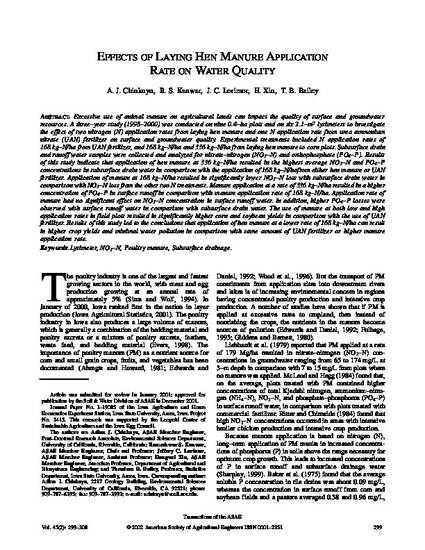
Excessive use of animal manure on agricultural lands can impact the quality of surface and groundwater resources. A three–year study (1998–2000) was conducted on nine 0.4–ha plots and on six 2.1–m 2 lysimeters to investigate the effect of two nitrogen (N) application rates from laying hen manure and one N application rate from urea ammonium nitrate (UAN) fertilizer on surface and groundwater quality. Experimental treatments included N application rates of 168 kg–N/ha from UAN fertilizer, and 168 kg–N/ha and 336 kg–N/ha from laying hen manure to corn plots. Subsurface drain and runoff water samples were collected and analyzed for nitrate–nitrogen (NO3–N) and orthophosphate (PO4–P). Results of this study indicate that application of hen manure at 336 kg–N/ha resulted in the highest average NO3–N and PO4–P concentrations in subsurface drain water in comparison with the application of 168 kg–N/hafrom either hen manure or UAN fertilizer. Application of manure at 168 kg–N/ha resulted in significantly lower NO3–N loss with subsurface drain water in comparison with NO3–N loss from the other two N treatments. Manure application at a rate of 336 kg–N/ha resulted in a higher concentration of PO4–P in surface runoff in comparison with manure application rate of 168 kg–N/ha. Application rate of manure had no significant effect on NO3–N concentration in surface runoff water. In addition, higher PO4–P losses were observed with surface runoff water in comparison with subsurface drain water. The use of manure at both low and high application rates in field plots resulted in significantly higher corn and soybean yields in comparison with the use of UAN fertilizer. Results of this study led to the conclusions that application of hen manure at a lower rate of 168 kg–N/ha can result in higher crop yields and minimal water pollution in comparison with same amount of UAN fertilizer or higher manure application rate.
Available at: http://works.bepress.com/rskanwar/81/

This article is from Transactions of the ASAE 45, no. 2 (2002): 299–308.